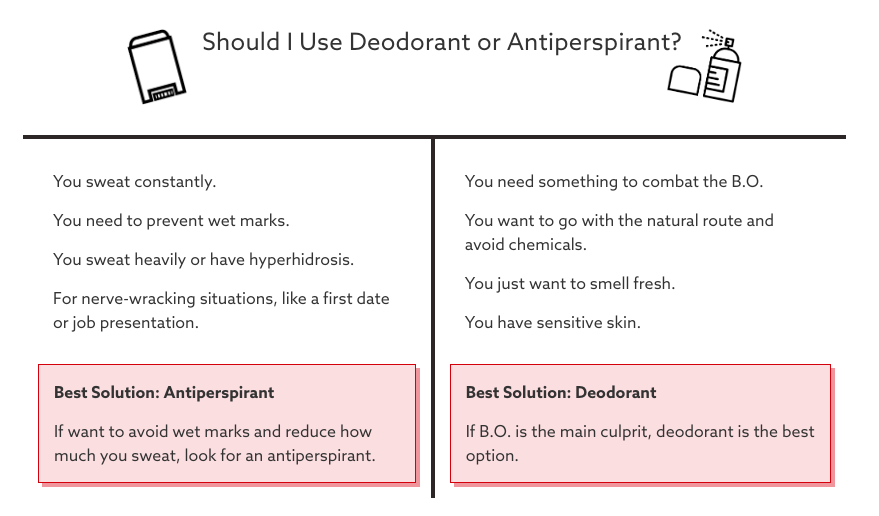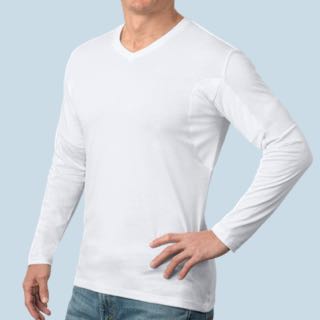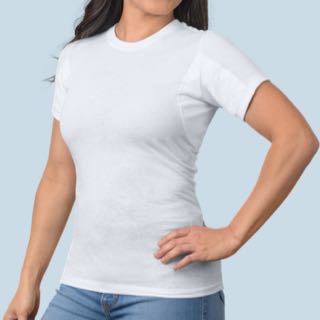Antiperspirant vs. Deodorant: The Difference & How to Choose Right
Here’s the key difference between deodorant and antiperspirant: Deodorant combats body odor, while antiperspirant blocks sweat.
We often don’t give it much thought when shopping for these products, assuming most store-bought options can fight both sweat and body odor (B.O.). However, stopping sweat and odor are two distinct issues that require different solutions. Let’s explore the deodorant vs. antiperspirant debate to help you choose the best option for your needs.
What Is Deodorant?
Deodorants are designed to combat B.O., which occurs when odorless sweat mixes with bacteria on your skin. While sweat itself is colorless and odorless, bacteria produce a smell when they break down fats and proteins in sweat. Deodorants prevent bacteria buildup and, by default, B.O.. However, they do not protect against perspiration or wetness.
With deodorant applied, you’ll still sweat, but you won’t smell. Deodorants come in various forms, including sticks, sprays and gels, with options ranging from scented to fragrance-free for sensitive skin.
Dealing with serious or uncontrollable B.O.? You may have bromhidrosis.
Deodorants typically contain antibacterials and fragrances. Some common ingredients include:
- Cetyl Alcohol
- Propylene Glycol
- Dimethicone
- Hydrolyzed Corn Starch
- Fragrance
- Cyclomethicone
Natural deodorants have gained popularity, often substituting traditional antibacterial agents with ingredients like baking soda, activated charcoal, or coconut oil.
Read more: How to Make Deodorant at Home [All-Natural Recipes]
How to Use Deodorant
Deodorant should be applied directly to the underarms.
Some suggest applying deodorant to other odorous areas of the body, like around the chest area or near the groin, but we advise against it. Instead, apply baby powder — a more natural, safer option.
Here are a few tips on how to use deodorant properly:
- Apply on dry skin: Apply deodorant after showering or before you go to bed when you aren’t prone to producing as much sweat.
- Reapply as needed: While you can reapply throughout the day, a few swipes usually suffice.
- Choose the right scent: Avoid clashing fragrances with cologne or perfume by selecting complementary or fragrance-free options.
- Consider portability: Travel-sized options make it easy to stay fresh on the go.
Read more: How to Get Rid of Armpit Odor: 11 Ways to Stay Fresh
How to Choose the Right Deodorant?
There are countless deodorants available, from popular name brands to natural, chemical-free options. Choosing the right one can feel overwhelming, but it’s important to remember that deodorants aren’t a one-size-fits-all solution. What works for someone else might not work for you.
To find the best deodorant for your needs, follow these steps:
- Check the label: Look for ingredients that suit your skin type or preferences, such as aluminum-free or fragrance-free formulas.
- Consider your lifestyle: If you’re active, opt for a long-lasting deodorant designed for sports or high-intensity activities.
- Conduct a trial run: Experiment with a few top picks to see which works best with your body chemistry and provides lasting odor protection.
- Account for sensitivity: If you have sensitive skin, choose products with gentle ingredients like aloe vera or avoid those with baking soda, which can irritate some skin types.
Read more: Deodorant Not Working Anymore? 11 Reasons Why
What Is Antiperspirant?
Antiperspirants reduce sweating by temporarily blocking sweat glands using aluminum compounds. When applied, these compounds form a gel that plugs sweat glands, significantly reducing sweat production.
Because antiperspirants alter a natural body function, the FDA classifies them as drugs. Contrary to common myths, aluminum-based antiperspirants are considered safe and do not cause cancer.
Antiperspirants come in various forms, including sticks, sprays, gels, and creams. Some cater to specific needs, such as clinical or prescription-strength products for excessive sweating (hyperhidrosis).
If your product contains any form of aluminum, it’s an antiperspirant. Common types include:
- Aluminum Chlorohydrate
- Aluminum Zirconium Trichlorohydrex Glycine
- Aluminum Hydroxybromide
- Sodium Aluminum Chlorohydroxy Lactate
While many natural ingredients like witch hazel, mineral salts, hops, baking soda and talc may reduce sweat, aluminum is the only ingredient recognized by the FDA as an antiperspirant. Anything labeled “aluminum-free antiperspirant” isn't guaranteed to stop sweat.
How to Use Antiperspirant
- Apply at night: Sweat glands are less active during sleep, allowing the product to work effectively.
- Allow time to dry: Ensure your skin is clean and dry before application.
- Consider broader use: Unlike deodorants, antiperspirants can be applied to other sweat-prone areas.
- Don’t overapply: Most antiperspirants provide 12-48 hour protection, reducing the need for frequent reapplication.
How to Choose the Right Antiperspirant
Antiperspirants are available in sprays, sticks, creams, gels, roll-ons, and solid sticks. No matter the format, the goal is the same: Reduce sweat and prevent pit stains. Keep these tips in mind when shopping for one:
- Strength levels: Choose based on your needs — extra strength for moderate sweat, clinical strength for heavy sweat, or prescription strength for excessive sweating like axillary hyperhidrosis or diaphoresis.
- Key ingredient: Look for aluminum chloride or similar compounds. Check the percentage for effectiveness, and consider gentler formulas if you have sensitive skin.
- Sweat patterns: For mild sweating, a drugstore option works fine. For workouts or excessive sweating, opt for clinical or prescription-strength products.
Deodorant-Antiperspirant Combinations
Many products combine deodorant and antiperspirant functions, masking odor while reducing sweat. These products often include fragrance and an aluminum-based compound. For example, Secret’s Clinical Strength Invisible Solid contains aluminum zirconium to block sweat and added fragrance to combat odor.
Antiperspirant vs. Deodorant: Which Is Right For You?
Choosing between deodorant and antiperspirant depends on your personal preferences, sweat levels, and the type of protection you're seeking. While both serve different purposes, understanding their unique functions can help you select the right product for your needs.
Deodorants are cosmetics designed to neutralize or mask B.O. by targeting the bacteria that cause it. They don’t stop sweat production, so they're best suited for those who sweat lightly or only need to prevent odor. If you're someone who experiences minimal underarm moisture but wants to feel fresh, deodorant can be your go-to.
Best for: Light sweating, people looking to prevent B.O. without blocking sweat.
Antiperspirants, classified as a "drug" by the FDA, are ideal for those who sweat heavily or experience underarm sweat marks frequently. By minimizing sweat, antiperspirants help prevent the dampness that can cause marks, leaving you with long-lasting dryness. Additionally, since the sweat is blocked, there’s less surface for odor-causing bacteria to cling to, making it easier to stay odor-free.
Best for: Heavy sweating, preventing sweat marks, long-lasting odor and sweat control.
Combination deodorant-antiperspirants are designed to give you both odor protection and sweat control in a single product. While these can be convenient for daily use, they may not be as effective as using separate products tailored to your specific needs. If you're seeking maximum results, using a deodorant and antiperspirant separately may be a better option.
Best for: Those looking for a quick, all-in-one solution, but may not be ideal for maximum sweat or odor control.
To get the most out of both products, consider layering them. Apply antiperspirant at night to block sweat while your body is at rest, and use deodorant in the morning to mask odor throughout the day. This method ensures that you benefit from both products' strengths, providing you with all-day freshness and sweat control.

Read more: 12 Alternatives to Keep Your Pits Dry
Deodorant or Antiperspirant Doesn’t Cut It? Try Thompson Tee
Thompson Tee offers a natural, chemical-free solution to control underarm sweat without the need for harsh antiperspirants.
Crafted with patented Hydro-Shield® technology, this sweat proof undershirt for men and women absorbs moisture and releases it as vapor, keeping you dry and comfortable throughout the day. When paired with deodorant, it creates a powerful sweat-blocking and odor-fighting combination that’s hard to beat.
If you're not a heavy sweater but still want to eliminate B.O., try our Premium Anti Odor Shirt. Featuring Odor Shield™ technology, it’s designed to keep you smelling fresh all day long.
Experience the difference — try it risk-free today!



